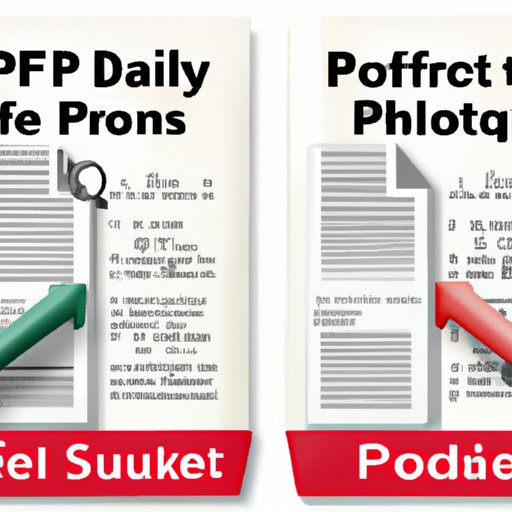
Introduction
Have you ever run into the issue of trying to share a document with someone, but the formatting just won’t stay the same? Or perhaps the file size is too large to send quickly. These problems can easily be solved by saving the file as a PDF. A Portable Document Format (PDF) preserves the document’s structure and formatting and optimizes the file size for easy sharing. In this article, we will provide a detailed guide on how to save a file as a PDF with different software and tools. From highlighting unique features to offering tips and tricks, this guide will help you master the art of PDF saving.
Step-by-Step Guide
How to save a file as a PDF in Microsoft Word
– Open the document you want to save as a PDF in Microsoft Word
– Click on ‘File’ in the top-left corner and choose ‘Save As’
– In the dialogue box ‘Save As,’ click on the ‘Save as type’ dropdown and choose ‘PDF’
– Name your file and choose the folder you want to save it in
– Click on the ‘Options’ button to change more settings if required
– Click on ‘Save’
How to save a file as a PDF in Google Docs
– Open the document you want to save as a PDF in Google Docs
– Click on ‘File’ in the top-left corner of the window and click on ‘Download’
– Select ‘PDF document (.pdf)’ from the dropdown
– Click on ‘Download’
How to save a file as a PDF in Adobe Acrobat
– Open the document you want to save as a PDF in Adobe Acrobat
– Click on ‘File’ in the top-left corner and choose ‘Save as Other’
– Click on ‘PDF’ in the dropdown
– Enter a name for the file and choose a location to save it in
– Click on ‘Save’
Highlighting Different Features
Benefits of saving files as PDFs
PDF files are universally recognized, and they ensure that the formatting and layout of your document remain consistent across different platforms and devices. PDFs are also relatively small in size, making it easy to store and share.
Unique Features of Different PDF Saving Tools & Software
Microsoft Word: Adding Security Features
Microsoft Word provides the option to password protect PDFs through its Protected View feature. You can limit access to your document by configuring viewing, editing and printing permissions, to ensure that it is only accessible to authorized personnel.
Google Docs: Directly Shareable Links
Google Docs makes file sharing seamless. Once you save a document as a PDF, you can share it through a direct link, and the recipient can view it from anywhere with an internet connection.
Adobe Acrobat: Creating Fillable Forms
Adobe Acrobat provides valuable features such as creating fillable forms. If you have a form that requires manual input, you can convert the document into a fillable one, thereby making it easier to obtain the necessary information.
Importance of PDF Format for Preserving File Formatting and Optimizing File Size
Thanks to the PDF format, the file formatting and layout are safe and intact, even if viewed on a different platform. Additionally, PDFs ensure that file sizes are optimized and kept to the bare minimum. So, if you’re looking to send a document that has to retain its layout, choosing a PDF format is the way to go.
Tips and Tricks
Keyboard Shortcuts for Quick Saving to PDF
Using keyboard shortcuts can greatly simplify file saving procedures. Pressing ‘Ctrl+P’ in Windows or ‘Command+P’ on a Mac will open the print dialogue box, from where you can select ‘Print to PDF’ or ‘Save as PDF’.
Third-Party Tools for Bulk PDF Conversions
Various third-party tools are available for bulk PDF conversion, including Adobe Acrobat, Nitro Pro, and Foxit PhantomPDF. These tools make it possible to convert many files to PDF format simultaneously.
Best Practices for File Naming Conventions
When choosing filenames, it’s essential to consider the purpose of the file and keep the name relevant and straightforward. Include the date and the version number for easy retrieval.
Lesser-Known Methods that can Make the Process Quicker and More Efficient
Tools like Hard Drive Powerwash assist in clearing out temporary files, freeing up space, and increasing the computer’s performance, ultimately speeding up the PDF conversion process.
Industry-Specific Saving Techniques
Saving Files in Graphics or Desktop Publishing Industries
Graphic designers and desktop publishers work with large files containing high-quality images or artwork. These files can quickly grow into gigabytes, making it hard to access or share them. By saving these files as PDFs, the files’ quality remains intact, and the file size gets optimized.
Particular Industry Professionals use Certain Unique Techniques or Tools
Engineers predominantly use PDF files to share blueprints or schematics. Still, they can also use more powerful features like optical character recognition (OCR) to extract text from scanned documents. This procedure allows engineers and other professionals to store information in an organized and easily accessible format.
Interactive Visuals
Visual aids help to convey complex information and provide step-by-step instructions for saving a document as a PDF. Using screenshots or videos to illustrate these steps can make it easier for users to follow along and successfully save their file as a PDF.
Conclusion
Saving files as PDFs is one of the best ways to ensure that formatting, and file size stay intact when sharing documents. In this article, we have provided an extensive guide to save files as PDFs, highlighted different features of saving software, offered tips and tricks to optimize PDF files, and touched on industry-specific saving techniques. By following the steps outlined in this guide and using the various tips highlighted, users can streamline the process and save their file as a PDF with ease.




